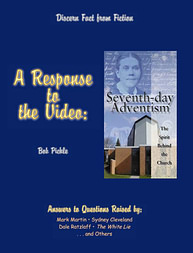|
A Response to the Video:
Seventh-day Adventism, the Spirit Behind the Church
by Bob Pickle
Answers to Questions Raised by:
Mark Martin, Sydney Cleveland
Dale Ratzlaff, The White Lie
. . . and Others
Discern Fact from Fiction
The Sabbath of the Fourth Commandment
< Prev T. of C. ... 161 162-163 164 165-167 168-169 170-174 175-176 ... Next >
| #165,
#166, & #167: "There was
still dissent however among Adventist followers. Mrs. White decided to
have another vision to settle the matter. A delegate to the conference reported that 'After the
conference,
November 20th, the vision was given, establishing those undecided on the sunset
time.' "—Narrator. |
#165: She decided to have another
vision. As shown under #44 and #112, for Mrs. White to decide to have another vision was an
absolute impossibility.
#166: There still being dissent, her vision was intended to settle the
matter. Actually, according to one account, the dissent
came from only two people, Joseph Bates and Mrs. White:
Now with the position of sunset time so amply supported by Scripture evidence, all the
congregation, which included the church's leaders, readily
accepted the light and were prepared to shift their practice. All, that is, but two—Joseph
Bates and Mrs. White.—Arthur White, vol. 1, p. 323.
Perhaps there were a few others, but the implication of the accusation is clear: Mrs.
White "decided" to have a vision to "settle the matter"
among the undecided: herself! Does not this seem a bit odd?
We'll comment a little further about the source of the narrator's quotation under #167. For now, consider the fact that other portions of this
very same source declare that the vision of November 20, 1855, never mentioned "sunset" at
all:
"3. We were present at the Conference referred to above, and also when the vision
was given after the close of that Conference, and heard Sr.
W. soon after coming out of vision, relate what she had seen. We are therefore prepared to
testify that sunset-time was not once mentioned in the
vision; but the words given to her in the previous vision were repeated, namely, 'From even
to even shall ye celebrate your Sabbath;' and these
words were now added: 'Take the word of God, read it, understand, and ye cannot err. Read
carefully, and ye shall there find what even is and
when it is.' In the first vision we were directed to the word of God by the
words 'From even to even;' but on astronomical grounds, it was then
decided that even was six o'clock. In the second, exactly the same words were used, and we
were more especially directed to the word of God, which
when examined conclusively establishes sunset time. This settled the matter with Bro. B. and
a few others, and general harmony has since prevailed
on the question."—Uriah Smith, Visions of Mrs. E. G. White, p. 91.
If Mrs. White "decided" to have a vision to convince dissenters to begin the Sabbath at
sunset, why didn't the vision she "decided" to have
say to begin the Sabbath at sunset?
#167: This is what a delegate reported. This quotation
from Uriah Smith is taken from his book The Visions of Mrs. E. G.
White,
which was written and published in 1866 and 1868. The 1866 edition was a reply to 39
quibbles, and the 1868 edition replied to another 13.
In the 1868 edition, the five-page section dealing with when to keep the Sabbath was entitled,
"Objection 32. - Time to Commence the Sabbath."
Why would the narrator ever want to quote from Smith's book, given the fact that it
disproves every one of these accusations? Since the
sentence the narrator quoted is the third-to-last sentence of the section, certainly some of the
contributors to the video must have read Smith's
explanations. They must therefore also know that these charges are entirely bogus (see #166, #168, #169, #174).

|

|
Like this book?
Save your printer and your ink!
Buy the entire 160-page book for
just
$9.95 + S/H.
Automatic discounts start
at 5 copies.
|
|
|
< Prev T. of C. ... 161 162-163 164 165-167 168-169 170-174 175-176 ... Next >
|



